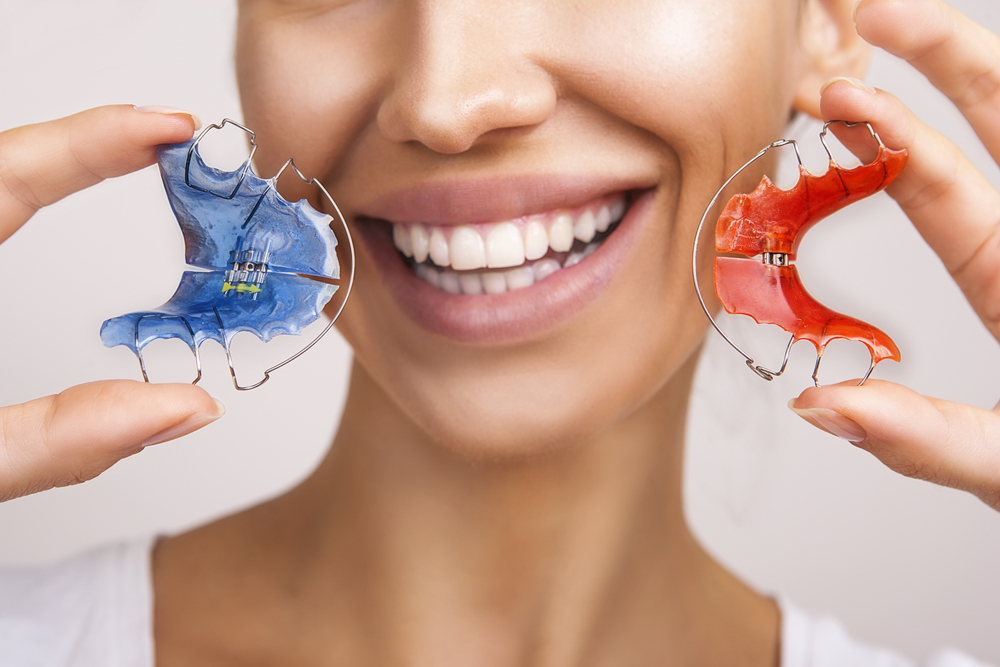Retainers are molded to the exact placement and structure of your teeth. Depending on what your orthodontist believes is best, you may be fitted for a permanent or removable retainer. Whatever the case is, the purpose of the retainer is to maintain the placement of your teeth that they were moved to when you had braces.
When you get your braces off, your teeth will naturally want to shift back to the position they were in before you got braces. The possibility of this happening diminishes over time, but it is a concern for at least the first 18 months after your braces are removed.
There is an “uprighting” movement of the front teeth on the lower jaw that occurs over a longer span of time. This movement is simply due to age and it is difficult to prevent.
Orthodontic treatment can fix crooked or misaligned teeth, but it can’t stop these processes. Retainers are important because they can combat the effects of these processes and keep your teeth in the ideal position.
How Do They Work?
A retainer is a metal or plastic instrument that keeps your teeth aligned. Once you have your braces removed, your orthodontist will make a mold of your teeth and create the retainer based on the new position of your teeth. Wearing the retainer habitually will keep your teeth from moving.
Retainers are great for more than just changing your appearance. Having straight teeth is beneficial for many developmental reasons. A misaligned bite can affect your speech patterns and damage your tooth enamel. It can even cause join problems. Once your bite is corrected through the use of braces, a retainer will keep it that way.
What are the Different Types of Retainers?
Essix Retainers
Essix retainers feel and look similar to Invisalign aligners. They are made from a clear plastic material so they aren’t very noticeable. Essix retainers are great because they serve the primary purpose of a retainer without being as expensive as a traditional retainer. Since they cover all of your teeth, they can also protect your teeth from the effects of grinding.
One disadvantage of Essix retainers is that they don’t last as long as other types of retainers. Some people also say that they can be easy to lose since they are clear.
Hawley Retainers
Hawley retainers are the most common type of retainer given to patients. They are made from an acrylic piece that sits on the roof of the mouth. A wire that wraps around the outside of the teeth is attached to the acrylic piece.
Hawley retainers are popular because they are ultra-durable. They can even be tightened and repaired. Another benefit of this type of retainer is that they allow your bite to settle into a comfortable position after extended use.
Since they don’t cover the teeth, they do not protect against grinding. They are also more expensive to replace. Because of the metal wire, they aren’t as discreet as clear plastic retainers. Some patients also dislike the feeling of the acrylic piece on the roof of their mouths.
Bonded Permanent Retainers
Bonded permanent retainers consist of a wire that is glued behind the lower front six teeth. Permanent retainers are most commonly placed here because those are the teeth that are most likely to move.
They are meant to be used in conjunction with removable retainers because they only protect your front teeth. It can be challenging to notice if your bonded retainer broke since it is located behind your teeth. It’s important to check on it often in case there is any damage. To prevent further orthodontic treatment, make sure your bonded retainer stays in working condition.
Do Retainers Have to be Worn Forever?
The answer to this question varies depending on the patient because there are many factors to consider. You don’t have to wear your retainer 24/7 for the rest of your life, but you should wear your retainer all of the time for at least 3 to 6 months after having your braces removed.
During these few months, your teeth will be more prone to moving. Once those few months past, your teeth will have stabilized. Then, you’re recommended to wear your retainer only at night. You should wear it for at least 1-3 years to prevent relapse.
Once you’ve been wearing it for several years, you can usually get away with wearing it only a few times a week. Again, this all depends on your teeth. Your dental care provider will recommend the right treatment plan for you.
What Do I Do if My Retainer Doesn’t Fit Anymore?
If you haven’t worn your retainer as consistently as you should, your teeth may have shifted significantly. If your retainer no longer fits after a long period of disuse, consult your orthodontist.
Depending on the severity of the misalignment, they can either fit your retainer or reapply braces. If the instrument is only slightly tight, the alignment of your teeth can usually be corrected in a short amount of time. However, you shouldn’t force it onto your teeth if it does not fit. This can cause a lot of damage.
Most patients experience shifting of the teeth after their braces have been removed. This process is natural, but wearing a retainer is the best way to prevent it. You should only stop wearing your retainer if your dental care provider said it was okay.
Contact Vellore Woods Dentistry Today
Retainers are effective appliances that keep your newly straightened teeth in the ideal position. Without them, the work of braces would quickly be undone. At Vellore Woods dentistry, we offer a host of orthodontic treatments. If you are dealing with misaligned or crowded teeth, contact us today by clicking here or call us at (905) 417-5550. We’d love to help you feel more confident in your smile.

